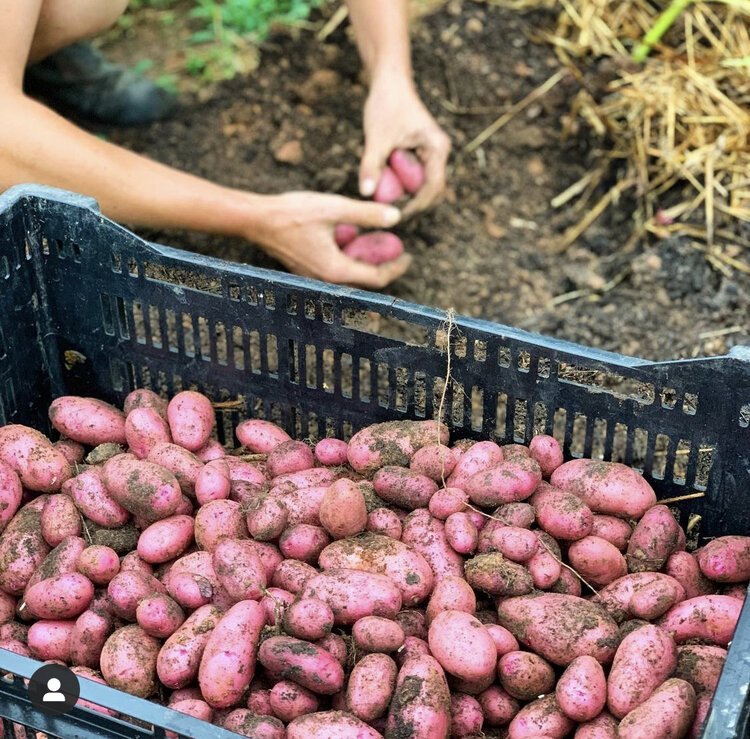Farm Notes
Goodness gracious, it’s been an eventful week around here! Last weekend we snuck away to the beach for a friend’s wedding, and it was so nice to get off the farm and dip our toes in the cold ocean for a bit. Though of course, we had some excitement waiting for us when we got home… we came to find that we had NO water to our house or to the farm, and it took a while to figure out the problem. Long story short, we had to call in an emergency electrician, and after quite a bit of stress the problem was fixed, and hallelujah we have water back! Never again will I take for granted how easily we are (usually) able to access water… it really is one of our most precious resources.
Oh! And did I mention that when we got home on Sunday, I also found that we had caught a groundhog (that had been munching on all our okra..)? THAT was fun. We also have a sweet baby who is so darn wonderful, but who happens to also be teething terribly and has decided that he absolutely does not want to nap during the day, so that has also been an adventure to navigate!
On the bright side, all of our summer veggies have taken off, and a large chunk of my farm work these days is just spent harvesting… tomatoes, potatoes, zucchini, peppers, eggplant, etc. This week we kicked off our 10-week Summer CSA, and it was a bountiful and delicious start to the summer season.
Summer CSA Week 1
Over the past week or two, we’ve been digging up our potatoes, and goodness gracious they are beautiful. We grew 6 or 7 different varieties this year, and so far my favorite is Gold Nugget (pictured below). They are SO prolific, have beautiful color and shape, and most important of all – they are so dang delicious. Definitely going to grow a lot more of this variety in years to come!
Freshly dug Gold Nugget potatoes
A few notes about harvesting potatoes… the time to harvest is typically after the potato plant has flowered and the foliage begins to turn brown and die off. I like to carefully pull up the plant, and then use my hands to dig around a few feet deep (and across the bed) to dig up any tubers that may be hiding.
After harvesting, you’ll also want to cure your potatoes for 10-14 days. Potatoes like to cure in a dark, humid, and cool environment (around 45-60F)... your fridge may be a little colder than is ideal, but it will work in a pinch! I usually keep the dirt on while the potatoes are curing, and don’t wash until I’m ready to eat them.
Why go the extra step of curing? Curing helps to thicken the skin of the potatoes, and it slows the respiratory rate – which will allow the spuds to store longer.
As for the many other tasks that have been keeping us busy around the farm... we've been working to keep up with the weeds, pull out our spring brassica plants, and to stay on top of pruning + trellising all the tomatoes, peppers, eggplant, and cucumbers! For a full farm update and some trellising tips, be sure to watch my virtual farm walk from today – you can watch via our Facebook Group HERE or at our Google Drive folder HERE.
In other news, it’s time to announce the winner of our most recent giveaway! CONGRATS Wendy Royce! I’ll be in touch with you directly to send you your new Victorinox chef knife. :)
Kitchen Notes
These days, I pretty much always have some kind of herby, lemony, garlicy yogurt sauce on hand, and I put it on EVERYTHING… roasted veggies! raw veggies! chicken! fish! toasted bread! This is a no-recipe kind of recipe (and as an added bonus, it comes together in about 5 minutes), so just use whatever herbs you have on hand, and in whatever quantity feels good to you.
Herby, Lemony, Garlicy & Good On Everything Yogurt Sauce
INGREDIENTS
2 cups plain greek yogurt
1/2 to 1 cup chopped fresh herbs (I like a combination of parsley, basil, dill, mint, chives, etc)
Juice + zest of 1 lemon
1 clove garlic, minced
3 tablespoons olive oil
Salt & pepper, to taste
PREPARATION
Scoop the yogurt into a medium sized bowl, and simply stir in all the remaining ingredients.
Taste and make adjustments as needed! Want more herbs? Throw a few more in! Needs more acid? Add more lemon! You get the idea. :)
Today’s Stats
Low temp: 63F
High temp: 85F
Sunrise: 6:00am
Sunset: 8:34pm
Moon phase: Waxing Gibbous
Additional notes: Sunny & warm


















